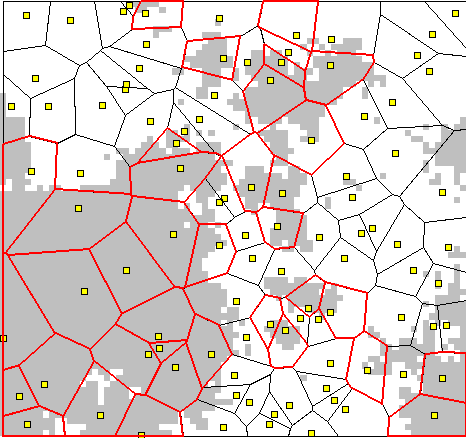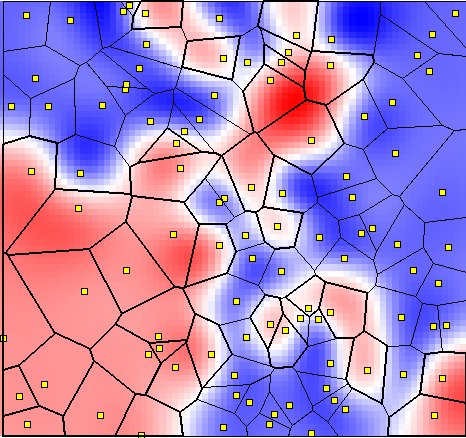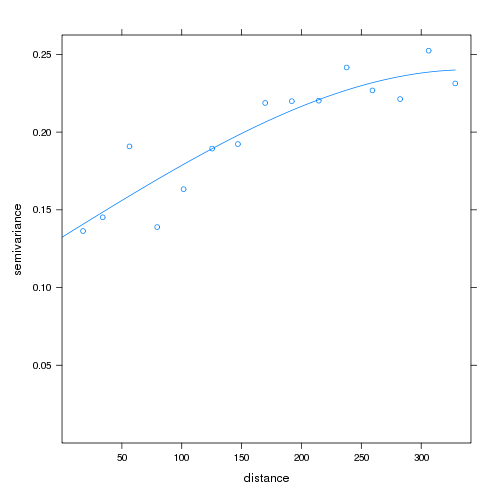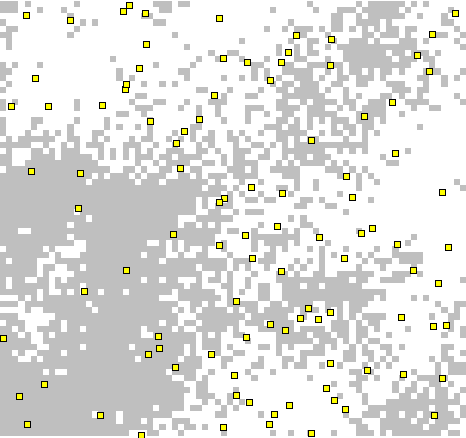Some Ideas on Interpolation of Categorical Data
Jan 15, 2009 metroadminPremise
Wanted to make something akin to an interpolated surface for some spatially auto-correlated categorical data (presence/absence). I quickly generated some fake spatially auto-correlated data to work with using r.surf.fractal in GRASS. These data were converted into a binary map using an arbitrary threshold that looked about right-- splitting the data into something that looked 'spatially clumpy'.

Fig. 1: Simulated auto-correlated, categorical variable, with sampling points and derived voronoi polygons.
I had used voronoi polygons in the past to display connectivity of categorical data recorded at points, even though sparsely sampled areas tend to be over emphasized. Figure 1 shows the fake spatially auto-correlated data (grey = presence /white = not present), sample points (yellow boxes), and voronoi polygons. The polygons with thicker, red boundaries represent the "voronoi interpolation" of the categorical feature.
Interpolation by RST
Wanting something a little more interesting, I tried interpolating the presence/absence data by via RST. Numerical interpolation of categorical data is usually not preferred as it creates a continuum between discreet classes-- i.e. values that do not have a sensible interpretation. Throwing that aside for the sake of making a neat map, a color scheme was selected to emphasize the categorical nature of the interpolated surface (Figure 2).

Fig. 2: RST interpolation of 0-1 continuum: red=1, blue=0.
Conditional Indicator Simulation
Finally, I gave conditional indicator simulation a try-- this required two steps: 1) fitting a model variogram, 2) simulation. This approach generates different output on each simulation, however, the output represents the original spatial pattern and variability. A more interesting map could be generated by running 1000 simulations and converting them into a single probability map.

Indicator Variogram: Empirical semi-variogram for indicator=1, with spherical model fit.

Categorical Interpolation 3: Single conditional indicator simulation.
Comparison



Code Snippets
Generate Some Data in GRASS
# set a reasonable resolution g.region res=10 -ap # simulate some spatially auto-correlated data # and convert to categorical map r.surf.fractal --o dimension=2.5 out=fractal r.mapcalc "fractal.bin = if(fractal > 0, 1, 0)" r.colors fractal.bin color=rules <<EOF 0 white 1 grey EOF v.random --o out=v n=100 v.db.addtable map=v v.db.addcol map=v column="fractal double, class integer" v.what.rast vect=v rast=fractal column=fractal v.what.rast vect=v rast=fractal.bin column=class # simplest approach v.voronoi --o in=v out=v_vor # try interpolation of classes... v.surf.rst --o in=v zcol=class elev=v.interp r.colors map=v.interp color=rules <<EOF 0% blue 0.5 white 100% red EOF
Perform Indicator Simulation in R
# indicator simulation
library(spgrass6)
library(gstat)
# read vector
d <- readVECT6('v')
# convert class to factor
d@data <- transform(d@data, class=factor(class))
# inspect variogram of x$class == 1
plot(v <- variogram(I(class == 1) ~ 1, data = d))
# fit a spherical variogram with nugget
# not sure about the syntax
v.fit <- fit.variogram(v, vgm(psill=1, model='Sph', range='250', 1))
# png(file='indicator_variogram.png', width=400, height=400, bg='white')
plot(v, model=v.fit)
# dev.off()
# make a grid to predict onto
G <- gmeta6()
grd <- gmeta2grd()
# new grid
new_data <- SpatialGridDataFrame(grd, data=data.frame(k=rep(1,G$cols*G$rows)), proj4string=CRS(d@proj4string@projargs))
# conditional indicator simulation:
# need to study this syntax
# make more simulations for an estimated probabilitry
p <- krige(I(class == 1) ~ 1, d, new_data, v.fit, nsim=1, indicators=TRUE, nmax=40)
# write one back to GRASS
writeRAST6(p, 'indicator.sim', zcol='sim1')
Make Some Maps in GRASS
# fix colors of the simulated map r.colors map=indicator.sim color=rules << EOF 0 white 1 grey EOF # simple maps d.erase d.rast v.interp d.vect v icon=basic/box size=7 fcol=yellow d.vect v_vor type=area fcol=none where=class=0 d.vect v_vor type=area fcol=none width=2 where=class=1 d.out.file --o out=example1 d.erase d.rast fractal.bin d.vect v icon=basic/box size=7 fcol=yellow d.vect v_vor type=area fcol=none where=class=0 d.vect v_vor type=area fcol=none col=red width=2 where=class=1 d.out.file --o out=example2 d.erase d.vect v_vor type=area fcol=white where=class=0 d.vect v_vor type=area fcol=grey where=class=1 d.vect v icon=basic/box size=7 fcol=yellow d.out.file --o out=example3 d.erase d.rast indicator.sim d.vect v icon=basic/box size=7 fcol=yellow d.out.file --o out=example4
Links:
Simple Map Creation
Working with Spatial Data
Target Practice and Spatial Point Process Models
Software
- General Purpose Programming with Scripting Languages
- LaTeX Tips and Tricks
- PostGIS: Spatially enabled Relational Database Sytem
- PROJ: forward and reverse geographic projections
- GDAL and OGR: geodata conversion and re-projection tools
- R: advanced statistical package
- Access Data Stored in a Postgresql Database
- Additive Time Series Decomposition in R: Soil Moisture and Temperature Data
- Aggregating SSURGO Data in R
- Cluster Analysis 1: finding groups in a randomly generated 2-dimensional dataset
- Color Functions
- Comparison of Slope and Intercept Terms for Multi-Level Model
- Comparison of Slope and Intercept Terms for Multi-Level Model II: Using Contrasts
- Creating a Custom Panel Function (R - Lattice Graphics)
- Customized Scatterplot Ideas
- Estimating Missing Data with aregImpute() {R}
- Exploration of Multivariate Data
- Interactive 3D plots with the rgl package
- Making Soil Property vs. Depth Plots
- Numerical Integration/Differentiation in R: FTIR Spectra
- Plotting XRD (X-Ray Diffraction) Data
- Using lm() and predict() to apply a standard curve to Analytical Data
- Working with Spatial Data
- Customizing Maps in R: spplot() and latticeExtra functions
- Converting Alpha-Shapes into SP Objects
- Some Ideas on Interpolation of Categorical Data
- Visual Interpretation of Principal Coordinates (of) Neighbor Matrices (PCNM)
- Visualizing Random Fields and Select Components of Spatial Autocorrelation
- Generation of Sample Site Locations [sp package for R]
- Target Practice and Spatial Point Process Models
- Ordinary Kriging Example: GRASS-R Bindings
- Point-process modelling with the sp and spatstat packages
- Simple Map Creation
- Comparison of PSA Results: Pipette vs. Laser Granulometer
- GRASS GIS: raster, vector, and imagery analysis
- Generic Mapping Tools: high quality map production

